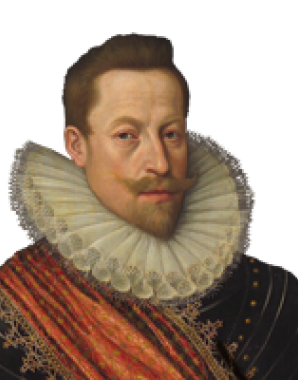Ferdinand of Tyrol: marriage and offspring
During his years in Prague Ferdinand entered into a liaison with Philippine Welser (1527–1580), the daughter of a wealthy Augsburg patrician, eventually marrying her in 1557. This morganatic union was initially kept secret from his father.
Not until 1559 did Ferdinand inform his father about the marriage, which he had contracted without the latter’s permission. At first he had to swear under oath to keep the marriage secret. Philippine thus officially lived together with her husband as his concubine. In 1576 Ferdinand was released from his oath by the Pope and was then able to recognize his wife officially.
The union produced two sons, Andreas and Karl, who were not counted as members of the Habsburg dynasty. Until the official announcement of their parents’ marriage they (together with two siblings who had died in infancy) were officially regarded as foundlings who had been taken into the archduke’s household ‘out of charity’.
The elder son, Andreas ‘of Austria’ (1558–1600), was made a cardinal in 1576 and was promised a bishopric to ensure an income for him – without his having taken holy orders. He eventually received the richly endowed benefices of the prince-bishoprics of Constance (1589) and Brixen/Bressanone (1591), where he is commemorated by the magnificent bishop’s palace. The cardinal’s activities, however, took place in the diplomatic rather than the pastoral sphere. His undiplomatic and at times ruthless actions make his legacy as governor of various Habsburg territories controversial. He fathered two illegitimate children, a son and a daughter. Andreas died during a visit to Rome, where he is buried.
The younger son Karl (1560–1618) also bore the name of Austria at first but was later made Margrave of Burgau and Count of Nellenburg and Hohenberg – all scattered Habsburg possessions in Swabia, where he assumed rulership. He tried his luck as a commander in the Spanish army, with varying success. He married late, when he was over forty, wedding the German princess Sibylle of Jülich-Cleves, his paternal niece, in 1601. As the union remained childless, this morganatic Habsburg line subsequently became extinct.
To return to Ferdinand: after the death of his first wife Philippine in 1580 he married for a second time in 1582. Bowing this time to dynastic demands, he married his niece Anna Caterina of Gonzaga-Mantua (1566–1621), daughter of his sister Eleonore, who was thirty-seven years his junior. She bore him three daughters, including Anna (b. 1585), who would later marry Ferdinand’s nephew Matthias, becoming empress at her husband’s side. Extremely religious, Ferdinand’s wife became a principal supporter of the Servite Order, a mendicant Catholic order that had arisen in Italy and devoted itself to the veneration of the Mother of God. She endowed the Servite Friary in Innsbruck and a nunnery of the same order in the Innsbruck Hofburg, which she entered as a widow together with her daughter Maria.













